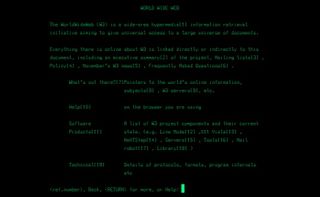Digital archaeology: Mark Boulton on recreating the early web
The author and designer explains his work on the Line Mode Browser project: a recreation of the first universally accessible web browser.
What was the Line Mode Browser project?
In September, 12 web designers and developers, together with the web team at CERN, got together to try and recreate the experience of browsing the first website on an early browser. The aim was to try and recreate that browser, document the story of how and why it came into being, and to launch something in the two days we were at CERN. Actually, in reality, it was less than two days – more like 36 hours.
This was part of a larger body of work with CERN to document the first website and the conditions in which the web was born.
Who worked on the project?
All in all, there were about 20 people involved throughout the few days. Some well-known web people were involved, in addition to people who were selected from a large number of applications to attend.
How much of the original browser exists?
Some binaries existed – and some people had compiled them to use – but the idea was that anyone could browse the first website in the Line Mode Browser, but in a modern browser environment. This meant we needed to create the thing from scratch, using modern development languages.

There are a few parts to the system: Node.js runs the browser and strips out a lot of HTML elements that weren't supported in the original browser, such as video. The CSS tries to emulate the experience, combined with sounds of random keystrokes, which were recorded on-site from an old IBM terminal that was running the original browser. We recreated an original typeface for the project based on the IBM terminal by taking photographs of the screen and hand-drawing each glyph before creating a web font.
What lessons can today's designers learn from your archaeology?
How a simple design system can still be incredibly powerful and engaging. I find myself browsing the first website – or by means of the bookmarklets we created, any website – and getting sucked into reading the content. The environment is really quite immersive, which is what we set out to do.
How will today's websites look in 20 years?
I think we will probably look upon them in the same way we judge websites from that long ago now: simple, almost laughable, in their approach, but admirable for pushing what was possible given the constraints of the medium at the time.
What has the reaction to the project been like?
The initial reaction in the community has been good, but the surprise was the response when the first URL was reinstated at the original address. The coverage was incredible – from the BBC through to The New York Times and CNN. It really seemed to capture the imagination of the general public. We still need to capitalise on that, but it was great to have some clear validation that this is important work.
Digital preservation is an increasing concern. Some of the stuff we're producing online has a physical shelf life. Optical drives and magnetic media degrade. Things break. Content is lost. Services are shut down and data deleted. All of this is the collective history of the web, and an important part of human communication in the 21st century. We need to preserve it – not for you or I, but for my daughters and their friends who, in 20 years time, will be able to look back and see how things changed, and why.
This article originally appeared in net magazine issue 248.
Liked this? Read these!
- Pro tips for the perfect website layout
- Our favourite web fonts - and they don't cost a penny
- Brilliant Wordpress tutorial selection

Thank you for reading 5 articles this month* Join now for unlimited access
Enjoy your first month for just £1 / $1 / €1
*Read 5 free articles per month without a subscription

Join now for unlimited access
Try first month for just £1 / $1 / €1
Get the Creative Bloq Newsletter
Daily design news, reviews, how-tos and more, as picked by the editors.
The Creative Bloq team is made up of a group of design fans, and has changed and evolved since Creative Bloq began back in 2012. The current website team consists of eight full-time members of staff: Editor Georgia Coggan, Deputy Editor Rosie Hilder, Ecommerce Editor Beren Neale, Senior News Editor Daniel Piper, Editor, Digital Art and 3D Ian Dean, Tech Reviews Editor Erlingur Einarsson and Ecommerce Writer Beth Nicholls and Staff Writer Natalie Fear, as well as a roster of freelancers from around the world. The 3D World and ImagineFX magazine teams also pitch in, ensuring that content from 3D World and ImagineFX is represented on Creative Bloq.
